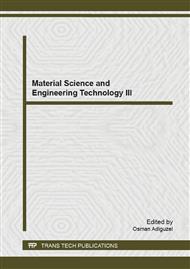p.89
p.93
p.99
p.104
p.108
p.115
p.120
p.124
p.129
The Influences of Ru Seed Layer Microstructure on Structural Properties of CoCrPt-SiO2 Perpendicular Media
Abstract:
CoCrPt-SiO2 granular film is well known as a perpendicular magnetic recording (PMR) media. To control the segregated structure of the recording layer, the role of the Ru underlayer is important. CoCrPt-SiO2 perpendicular recording films were prepared by magnetron sputtering, with a series of Ru films as seed layer. The microstructure of Ru seed layers and their influences on the grain size, roughness and surface morphology of CoCrPt-SiO2 granular films were investigated. It was found that the microstructure of seed layer obviously effected the structure and grain isolation of recording layers. The grain size and roughness of CoCrPt-SiO2 recording layer were both increased with increasing the thickness of Ru seed layer. It is concluded that the thin and rough Ru seed layer is suitable for high-density magnetic recording media, and Ru seed layer with suitable thickness is very helpful for the achievement of perfect isolation and excellent magnetic properties. The result revealed that it was relatively easy for the CoCrPt grains to get perfect isolation with Ru thickness of 70 nm.
Info:
Periodical:
Pages:
108-114
Citation:
Online since:
April 2015
Authors:
Price:
Сopyright:
© 2015 Trans Tech Publications Ltd. All Rights Reserved
Share:
Citation:


